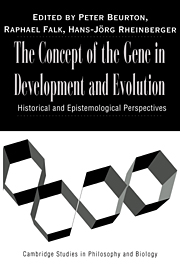Book contents
- Frontmatter
- Contents
- Introduction
- List of Authors
- PART ONE GENES AND TRAITS
- PART TWO EXTRACTING THE UNITS OF HEREDITY
- 4 From Measurement to Organization: A Philosophical Scheme for the History of the Concept of Heredity
- 5 From Gene to Genetic Hierarchy: Richard Goldschmidt and the Problem of the Gene
- 6 Seymour Benzer and the Definition of the Gene
- PART THREE GENETIC PROGRAMS AND DEVELOPMENTAL GENES
- PART FOUR CONCEPTUAL PERSPECTIVES
- FINAL REVIEW
- Glossary
- Index
6 - Seymour Benzer and the Definition of the Gene
from PART TWO - EXTRACTING THE UNITS OF HEREDITY
Published online by Cambridge University Press: 12 January 2010
- Frontmatter
- Contents
- Introduction
- List of Authors
- PART ONE GENES AND TRAITS
- PART TWO EXTRACTING THE UNITS OF HEREDITY
- 4 From Measurement to Organization: A Philosophical Scheme for the History of the Concept of Heredity
- 5 From Gene to Genetic Hierarchy: Richard Goldschmidt and the Problem of the Gene
- 6 Seymour Benzer and the Definition of the Gene
- PART THREE GENETIC PROGRAMS AND DEVELOPMENTAL GENES
- PART FOUR CONCEPTUAL PERSPECTIVES
- FINAL REVIEW
- Glossary
- Index
Summary
ABSTRACT
The mapping of the fine structure of the gene by Seymour Benzer, between 1954 and 1962, redefined the gene and brought classical genetics into contact with the molecular interpretation of genetic material based on the DNA double helix. The present essay sets Benzer's investigation into its immediate context, follows the development of Benzer's experimental program, and explores the impact of his work on the conceptual structure of genetics as reflected in contemporary textbooks.
INTRODUCTION
In 1954, Seymour Benzer began mapping the fine structure of the rII region of the genome of the bacteriophage T4. By the time he ended this work in 1961 (Benzer 1966,157), it had become a central support for what Petter Portin has defined retrospectively as the “neoclassical concept of the gene” (Portin 1993,173-175,186-187). In his textbook Molecular Biology of the Gene, which provided the first pedagogical synthesis of the newly established field of molecular biology, James Watson derived “the geneticist's view of a gene” mainly from Benzer's analysis:
a discrete chromosomal region which (1) is responsible for a specific cellular product and (2) consists of a linear collection of potentially mutable units (mutable sites), each of which can exist in several alternative forms and between which crossing over can occur.
(Watson 1965, 233)This definition was synonymous with what Benzer had called a cistron, because he based it on a criterion known as the cis-trans test for a functional unit of the genome.
- Type
- Chapter
- Information
- The Concept of the Gene in Development and EvolutionHistorical and Epistemological Perspectives, pp. 115 - 156Publisher: Cambridge University PressPrint publication year: 2000
- 17
- Cited by



